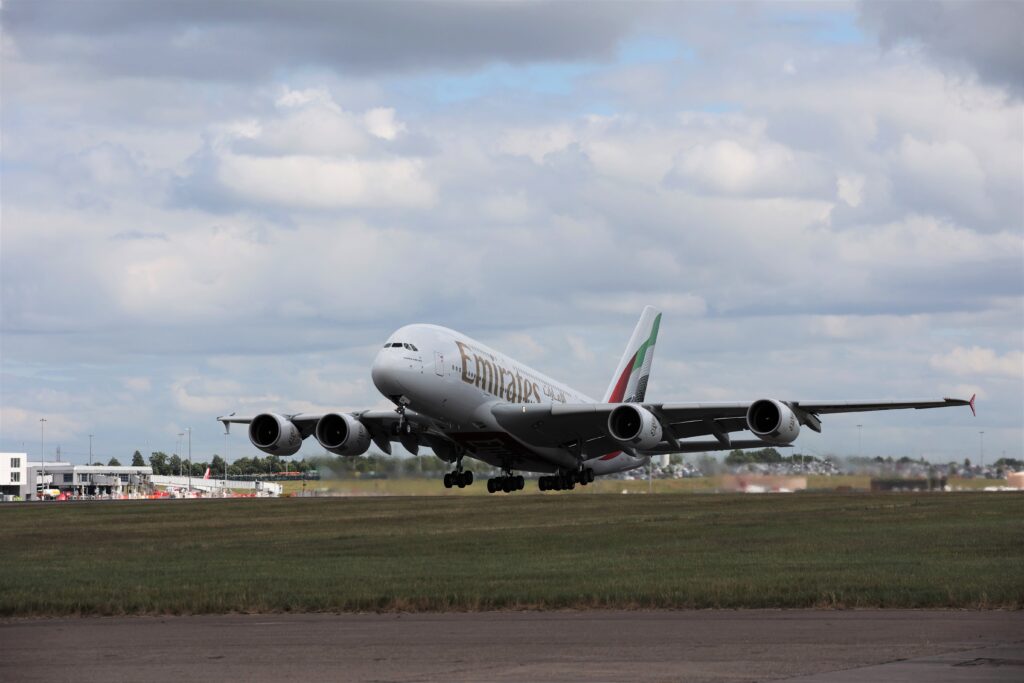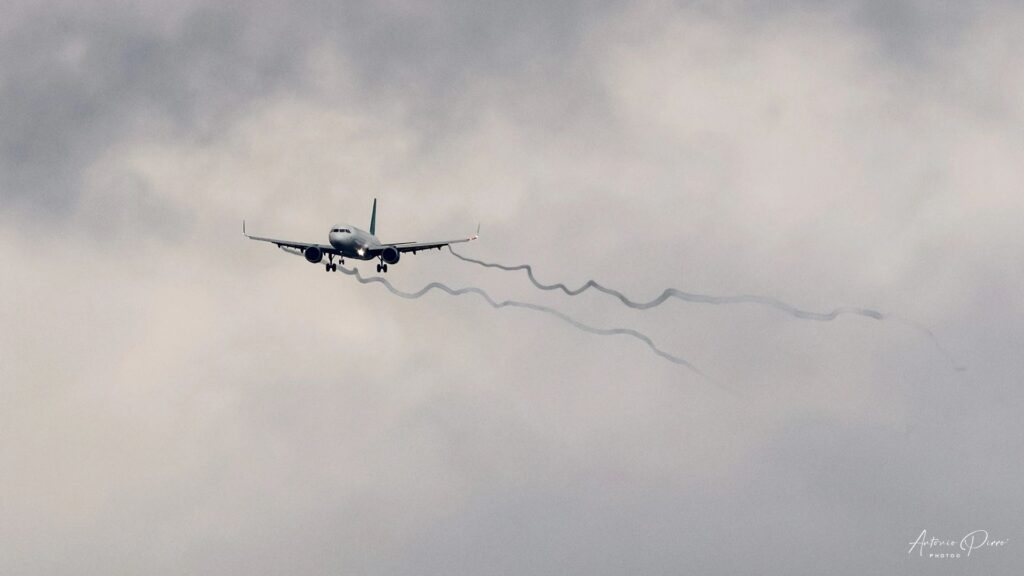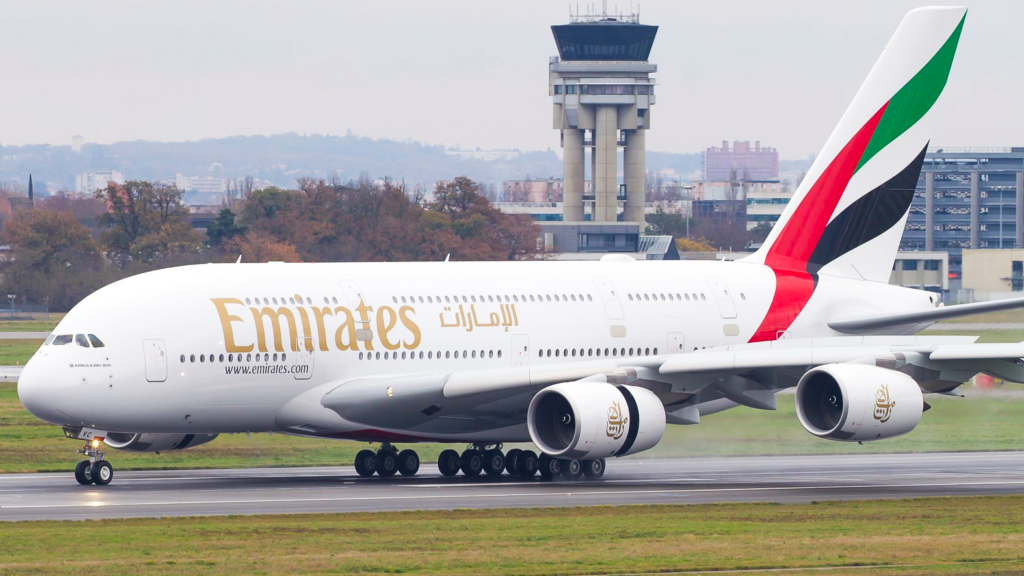
Сан-Франциско- Несколько дней назад популярный авиационный канал YouTube поделился видео, на котором Emirates (EK) Airbus A380 совершает обход в международном аэропорту Сан-Франциско (SFO).
Обход вокруг обычное явление, но это было так гладко, что, несмотря на сдвига ветра, пилоты вытащили один из самых гладких обходов A380.
 Фото: Эмирейтс
Фото: ЭмирейтсЭмирейтс A380 Go-Around
По данным источника Aviation A2Z (проверено с использованием данных Flight), инцидент произошел 19 марта 2025 года и включал рейс Emirates EK225 (UAE51N) с Airbus A380-841, зарегистрированным как A6-EUV, работающим на четырех двигателях Rolls-Royce (RR).
По данным Flight По предварительным данным, рейс Эмирейтс EK225 покинул ворота A23 Международного аэропорта Дубая (DXB) в 8:57 по местному времени. Пробыв в воздухе около 16 часов, самолет попытался приземлиться в SFO.
К сожалению, A380 был свидетелем лобового сдвига на высоте 50 футов, и после этого экипаж совершил обход. Он благополучно приземлился в SFO и доехал до ворот A6.
Для тех, кто не знает о Go-around и Windshear, вот краткое описание:
 Фото: Аэропорт Бирмингема
Фото: Аэропорт БирмингемаЧто такое Go-Around?
Протоколы авиационной безопасности включают в себя критическую процедуру, называемую обходом, которая возникает, когда самолет прерывает свой посадочный подход и присоединяется к очереди посадки. Пилоты или авиадиспетчеры инициируют этот маневр, когда условия посадки не соответствуют требованиям безопасности.
Несколько ситуаций вызывают обходные пути. Пилоты выполняют эту процедуру при столкновении с нестабилизированными конечными подходами. Контроллеры заказывают обходные пути, когда разделение между самолетами уменьшается или возникают проблемы с связью. Автомобили аэропорта иногда посягают на взлетно-посадочные полосы, что требует корректировки траектории полета в последнюю минуту.
Авиационная промышленность рассматривает обходные пути как важнейшие инструменты безопасности, а не проблемные явления. Типичный обход создает только 10-15-минутную задержку, уделяя приоритетное внимание безопасности пассажиров и самолетов.
Прогулки по SFO
Данные FAA Air Traffic Organization показывают, что обходы составляют около 0,3% прибытий в крупных аэропортах по всей стране, причем ставки варьируются от 0,2% до 0,6%. Международный аэропорт Сан-Франциско (SFO) сообщает о плавающих ставках в размере 0,3% в 2016 финансовом году и 0,4% в 2017 финансовом году, что соответствует 2-3 ежедневным событиям. Эти статистические данные ставят SFO в пределах нормальных параметров по сравнению с другими крупными аэропортами.
Команда LeighFisher проанализировала данные о полетах SFO, охватывающие 2015-2018 годы, чтобы определить закономерности в обходных инцидентах. Их исследование выявило несколько заметных корреляций.
- В летние месяцы обходы происходили в 1,4 раза чаще, чем осенью или ранней весной.
- Самолеты, приземляющиеся на менее часто используемых взлетно-посадочных полосах, испытали в 1,8-4,0 раза больше обходов, чем те, которые используют взлетно-посадочные полосы первичного прибытия.
- Пик прибытия показал в 1,5 раза больше обходов, чем периоды полудня с меньшим объемом трафика.
Тип самолета также влияет на вероятность обхода. Широкофюзеляжные самолеты инициировали обходы в 1,1 раза чаще, чем узкофюзеляжные или региональные самолеты. Небольшие самолеты, включая реактивные самолеты, турбовинтовые и пропеллерные самолеты, показали в 1,2 раза более высокие скорости обхода. Иностранные пассажирские перевозчики выполнили В 1,4 раза больше обходов чем их американские коллеги.
На основе этого обширного сбора данных команда LeighFisher разработала схему классификации шести категорий для документирования обходных путей. Эти категории варьируются от рутинных маневров без непосредственных проблем безопасности до чрезвычайных процедур, предотвращающих потенциальные аварии.
SFO демонстрирует приверженность безопасности взлетно-посадочной полосы своим проактивным подходом. Аэропорт проводит ежемесячные встречи по безопасности взлетно-посадочной полосы и поддерживает постоянную координацию с FAA и авиакомпаниями для анализа причин обхода и частот. Эти совместные усилия помогают выявлять закономерности и осуществлять превентивные меры.
Аэропорт подчеркивает, что 97,4% Объезды в SFO начинаются как минимум в одной миле от аэропорта. Погодные условия играют значительную роль, поскольку нестандартные конфигурации взлетно-посадочной полосы, вызванные неблагоприятными погодными условиями, коррелируют с увеличением инцидентов обхода.
 Фото: Антонио Пирро ?
Фото: Антонио Пирро ?Что такое Windshear?
Сдвиг ветра представляет значительную опасность для самолетов во время критических фаз полета, особенно во время взлета и посадки. Это явление включает в себя внезапные изменения скорости или направления ветра, которые могут резко повлиять на производительность самолета с небольшим предупреждением.
По данным Международной организации гражданской авиации (ИКАО), сдвиг ветра проявляется в двух основных формах. Вертикальный сдвиг ветра происходит, когда горизонтальное направление ветра или скорость изменяются с высотой, измеряемой несколькими анемометрами, расположенными на разных высотах на одной мачте. Горизонтальный сдвиг ветра включает изменения в горизонтальном направлении ветра или скорости на расстоянии, обнаруженные анемометрами, установленными на одинаковых высотах вдоль взлетно-посадочной полосы.
Турбулентность низкого уровня представляет особую опасность для самолетов на этапах вылета или прибытия. Это опасное состояние обычно сопровождает определенные погодные явления. Фронтальные поверхности, где встречаются различные воздушные массы, создают среду, способствующую развитию сдвига ветра. Реактивные потоки с их быстрым движением воздуха и четкими границами создают значительные градиенты ветра. Грозы и конвективные облака, особенно кучевые или возвышающиеся кучевые образования, производят интенсивные восходящие и нисходящие потоки, приводящие к сильному сдвигу ветра.
Горные волны образуются, когда устойчивый воздух течет по горной местности, создавая колеблющиеся структуры воздушного потока, простирающиеся далеко вниз по ветру от самих гор. Микровсплески, пожалуй, самое опасное проявление, состоят из мощных нисходящих потоков, которые распространяются наружу при ударе о землю, создавая быстро меняющиеся и непредсказуемые условия ветра.
Операционные последствия сдвига ветра во время подхода могут быть серьезными. Самолеты, испытывающие горизонтальный или вертикальный сдвиг ветра, могут внезапно пострадать от потери скорости и очевидного снижения мощности, что может привести к катастрофическим последствиям.
Быстрое изменение ветровой составляющей или дрейф перед посадкой дестабилизирует подход в критические моменты, когда обходные маневры становятся невозможными или чрезвычайно опасными.
Пилотная реакция на сдвига ветра должна быть немедленной и точной. Первый важный шаг включает быстрое распознавание условий сдвига ветра, а затем безотлагательное выполнение соответствующих процедур восстановления. Учебные программы подчеркивают эти навыки распознавания и соответствующие методы реагирования в качестве основных элементов авиационной безопасности.
Аэропорты в районах, подверженных условиям сдвига ветра, обычно используют специализированные системы обнаружения для раннего предупреждения приближающихся и вылетающих самолетов. Эти системы в сочетании с метеорологическим прогнозированием и осведомленностью пилотов образуют многослойную защиту от инцидентов, связанных с сдвигом ветра.
Вот видео со всеми подробностями:
Вот видео транскрипт с помощью разговора LiveATC, используемого внутри:
- О, он ходил вокруг
- Что случилось, я слышу по радио
- Что случилось, да, что случилось, это
- а Это большой Это много, чтобы обойти
- Это было ужасно в последнюю минуту 51
- Ноябрьская взлетно-посадочная полоса Super Fly
- поддерживать 3000 взлетно-посадочных полос, направляющихся 3000
- Эмирейтс 51 Ноябрьский забег был
- ветряк
- Эмираты 51 ноября супер причина поехать
- Теперь, пожалуйста, подождите
- Я позвоню тебе через минуту, Эмираты 51
- ноябрь
- 1340 выше 28 справа 1340 Сан Сан Сан
- Башня Франсиско предупреждает о турбулентности
- тяжелый
- [Аплодисменты]
- [Музыка]
- Супер-автобус проехал около 28-го.
- Земля в порядке, спасибо, у вас есть
- Ветер проверить это
- ветер 270 7 270 7
- Спасибо Эмиратам 51 ноября Супер
- контакт 135.1.
- 1351 51 Ноябрь Извините, что не смог
- Раньше это было твоим,
- Виндшер около 50 футов, спасибо
- 1340 будет супер Airbus
- Об этом сообщает Windshare at 50ft on
- Взлетно-посадочная полоса
- No Эмирейтс 51 Ноябрь Супер
- вокруг взлетно-посадочной полосы 28 прямо ваш лобовое стекло на 50 футов отслеживание до VQ 3000
- ft 4733 Сан-Франциско Tower Runway 28
- Правильное четкое движение по суше
- Тяжелая коррекция Super Airbus
- Доля ветра на взлетно-посадочной полосе в 50 футах справа
- Чистая земля 4733 roger
- О, он ушел
- О том, что случилось, я ничего не слышал.
- Радио: что случилось, что случилось
- Это то, что является большим Это много, чтобы пойти
- Это было ужасно в последнюю минуту.
 Emirates Airbus A380 | Фото: Клемент Аллоинг
Emirates Airbus A380 | Фото: Клемент АллоингПровал Emirates Go-Around
Airbus A380 испытал экскурсию по взлетно-посадочной полосе во время посадки в Сингапуре, когда пилот-летчик не смог надлежащим образом отреагировать на инструкции пилот-мониторинга. Серьезный инцидент произошел 2 марта 2023 года в 14:27 по местному времени на фоне сильных осадков, согласно итоговому отчету Бюро расследований транспортной безопасности Сингапура (TSIB).
Самолет, зарегистрированный как A6-EVJ, завершал свою службу в Дубае и Сингапуре, когда он столкнулся с ухудшением погодных условий во время окончательного подхода. Пилот Flying сообщил, что усиление дождя повлияло на его возможности по обращению с самолетом во время подхода ILS к взлетно-посадочной полосе 02L.
На высоте 180 футов пилот отключил автопилот, поскольку оба члена экипажа наблюдали, как самолет дрейфует прямо с центральной линии взлетно-посадочной полосы. Pilot Flying применил левую палку и руль, чтобы исправить это отклонение. Несмотря на признание несоответствия, он утверждал, что безопасная посадка осталась возможной.
Пилотный мониторинг призвал к «обходу», когда самолет достиг 30 футов над уровнем земли. Пилот ответил: «Нет, все в порядке» и продолжил подход. Позже он сказал следователям, что на самом деле не понимает, что сказал пилот-мониторинг, но решил не искать разъяснений, вместо этого сосредоточившись на посадке самолета.
Второй «обходной» звонок поступил от Pilot Monitoring во время приземления. Пилот не признал и не ответил на эту инструкцию и продолжил посадочный крен. В последующих интервью пилот заявил, что не слышал второго звонка.
Экскурсия по взлетно-посадочной полосе привела к повреждению трех фонарей взлетно-посадочной полосы и пробитой шины самолета, хотя ни один пассажир или член экипажа не получил травм.
Эмирейтс приняла ряд мер безопасности после инцидента. 17 марта авиакомпания поделилась подробностями экскурсии со всеми летными экипажами и разработала тематическое исследование о мероприятии для периодических учебных программ пилотов.
Эмирейтс подчеркивает, что во время ежегодного обучения по управлению ресурсами экипажа и технической подготовки пилоты должны выполнить этот маневр без вопросов. Авиакомпания также поручает персоналу Pilot Monitoring подготовиться к взятию под контроль и выполнению пропущенного подхода, даже если самолет уже коснулся земли.
Изображение: Clément Alloing | Flickr
Оставайтесь с нами. Следуйте за нами в социальных сетях для последних обновлений.
Присоединяйтесь к нам в Telegram Group для последних обновлений авиации. Следуйте за нами в Google News
Пилоты Emirates A380 прервали взлет в аэропорту Бирмингема
Пилоты Emirates A380 выполняют Go-Around на высоте 50 футов в Сан-Франциско впервые появились на Aviation A2Z.

















